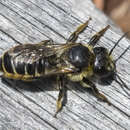Conservation Status
University of Alberta Museums tarafından sağlandı
No information indicating any concern.
- lisans
- cc-by-nc
- telif hakkı
- University of Alberta Museums
Cyclicity
University of Alberta Museums tarafından sağlandı
Emerge early July to early August (Fye 1965). May to October in southern parts (Mitchell 1962).
- lisans
- cc-by-nc
- telif hakkı
- University of Alberta Museums
Distribution
University of Alberta Museums tarafından sağlandı
MacKenzie to Newfoundland and south to Arizona, Tennessee, California, Illinois and Georgia (Krombein et al. 1970).
- lisans
- cc-by-nc
- telif hakkı
- University of Alberta Museums
General Description
University of Alberta Museums tarafından sağlandı
"Females: Relatively small body size with a length of 9-12 mm, stout and completely black body with yellow spurs (articulated spine). Eyes become slightly convergent near the bottom. Soft downy hair (pubescence) is white and is quite dense around the antennae, lower face, cheeks, lateral and posterior thorax, lateral abdomen, and between dorsal abdomen segments. Wings are subhyaline (sub transparent). Large cheeks, only slightly wider than the eyes and mouth mandibles have 5 tooth projections. Pollen collecting “scopa” on the ventral abdomen with dense yellowish short hairs. (Mitchell 1962).
Males: Body length of 8-10 mm, stout and completely black body and slightly reddish legs. Eyes become slightly convergent near the bottom. Large cheeks that are slightly wider then the eyes and mouth mandibles have 3 tooth projections. Pubescence are white and very dense around the antennae, lower face, cheeks below, lateral and posterior thorax. Wings are subhyaline (sub transparent). Tergum (dorsal abdomen segment) 7 is prominent, broad, short and has a deep excavation. Sternum (ventral abdomen segment) 5 is short and restricted. Sternum 6 has few setae on each side of the midline with no obvious apical lobe. Genital armatures have slender gonocoxites with a sharp appearing apex. (Mitchell 1962)."
- lisans
- cc-by-nc
- telif hakkı
- University of Alberta Museums
Habitat
University of Alberta Museums tarafından sağlandı
Prefers nesting sites at woodland edges (Medler & Koerber 1958); bores into wood (Krombein et al.).
- lisans
- cc-by-nc
- telif hakkı
- University of Alberta Museums
Life Cycle
University of Alberta Museums tarafından sağlandı
Reported univoltine (one generation reaches maturity per year) in Ontario and bivoltine (two generations reaches maturity per year) in Wisconsin (Fye 1965, Medler & Lussenhop 1968). Nests are constructed by the mother bee with loosely packed leaf pieces to create the thimble-shaped cells and the nest entrance is plugged with circular leaf pieces (Medler & Koerber 1958) followed by a layer of chewed leaves and clay (Fye 1965, Medler & Koerber 1958). Nests appear rough in texture (Fye 1965). Eggs are laid in the cells and hatch 2 - 3 days later. There are 4 larval stages, which feed on the provisioning left by the mother bee (Medler & Koerber 1958). The last larval stage produces a reddish brown silk cocoon in the cell and pupates approximately 7 to 10 days later and all of the adult bees in the nest emerge at the same time (Medler & Koerber 1958). Nesting under rocks has been observed in Wisconsin (Medler & Lussenhop 1968). Nest site competition has been observed where eumenid and pompilid wasps take over M. relativa nests and vica versa (Medler & Koerber 1958). Parasitism by parasitic bees includes Coelioxys spp. and the large chalcoid wasp Leucospis affinis (Krombein 1970, Medler & Koerber 1958).
- lisans
- cc-by-nc
- telif hakkı
- University of Alberta Museums
Trophic Strategy
University of Alberta Museums tarafından sağlandı
Polylectic (collects pollen from wide range of flowering plants) (Krombein et al. 1970). Pollen from various flowers includes Aster spp. and Rubus spp. (Krombein et al., Medler & Koerber 1958). Commonly cut leafs for their nests from flower species including Amelanchier spp., Epilobium anustifolium and Lonicera canadensis (Fye 1965).
- lisans
- cc-by-nc
- telif hakkı
- University of Alberta Museums

